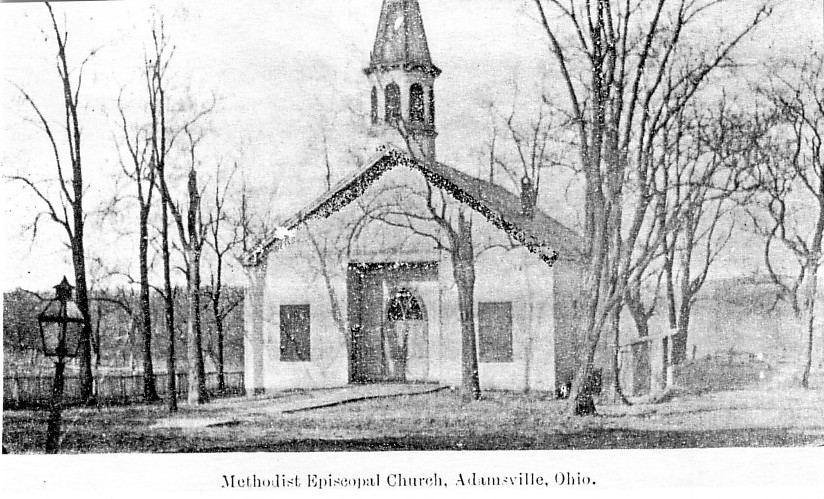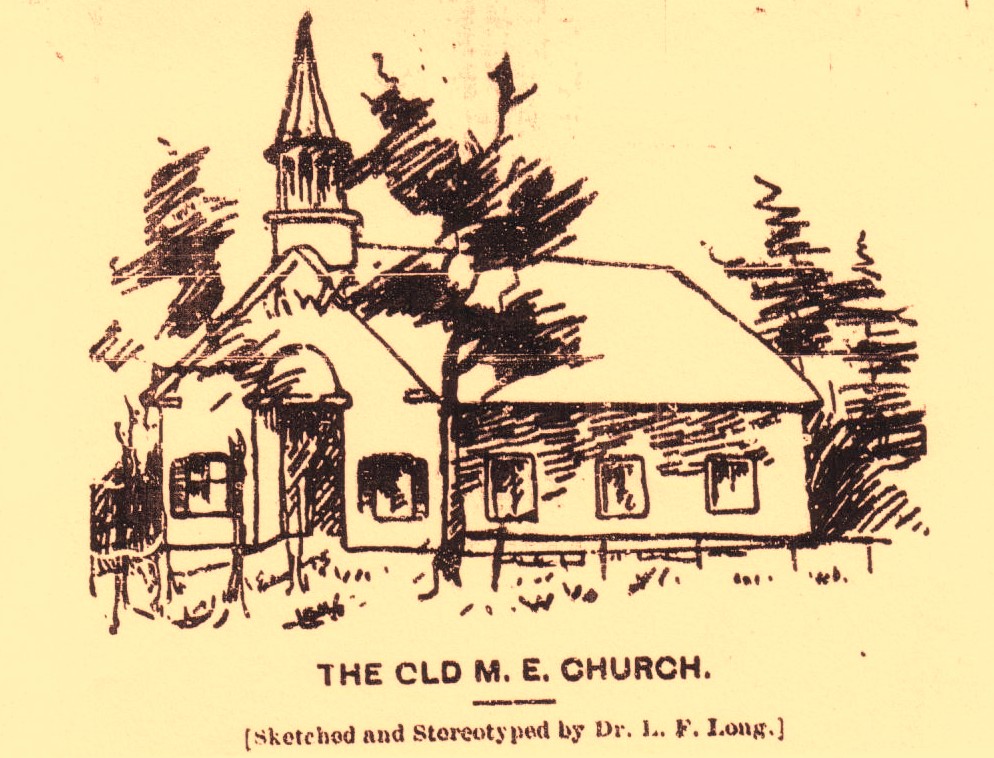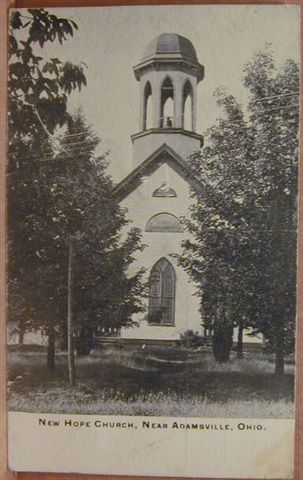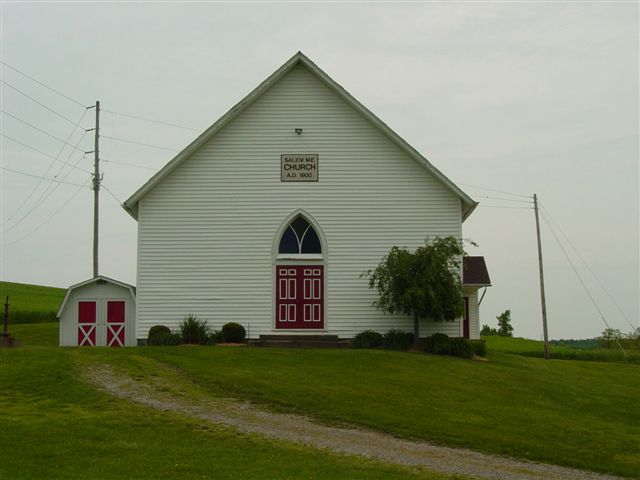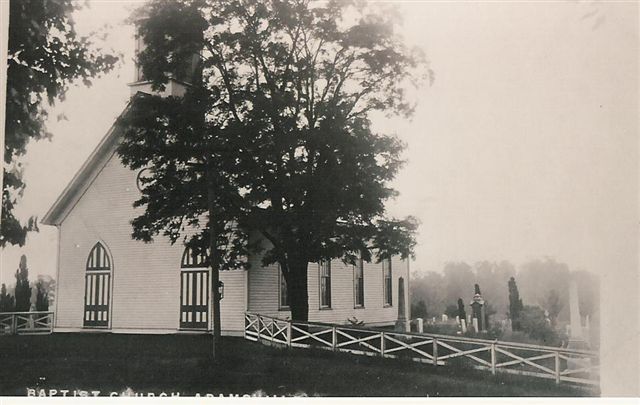Jacob Gaumer, Sr. and his family and others founded a Church and Cemetery in Salem Township, Muskingum County, Ohio, known then and now as New Hope German Lutheran Protestant Church. The Church and Cemetery are located one and one half miles east of Adamsville, Ohio, on highway 75, running from Zanesville, Ohio to Coshocton, Ohio. The pioneers of the section of Muskingum County, Ohio, arrived in the year of 1806. They first located along the lowlands of the Muskingum River, where they became afflicted with ague, so frequently and seriously as to be forced to move to the hills. Here a more healthful location was found, the air more invigorating and plentiful pure water from perennial springs, issuing from almost every hillside.
They came from Virginia, Maryland and Pennsylvania; A number of these pioneers became Charter members of the New Hope Congregation. They were nearly all Lutheran or Reformed Church among whom the following family names were most prominent: Namely: Gaumer, Shroyer, Werts, Baintor and Sturts. These devoted people looked to their Sprirtual as well as their temporal welfare as they entered the dense forests to establish for themselves an earthly home.
They did not only entertain "New Hope" for their material prosperity, but, also, for their growth in grace. They were not here long before they sought to be administered unto the Word and Sacraments.
The New Hope Church was organized in the year 1811 by Rev. Anthony Weyer. This organization ante-dated all others of its kind, in a large scope of country in this section of Muskingum and adjacent counties, by several years.
The first Church was erected in 1814 and was dedicated by Rev. Andrew Henkel. It is maintained that the first funeral service in the neighborhood, Sept., 1814 was held in this Church. The congregation numbered about 40 communicants at the time, which gave proof of the need for a house of worship.
The first Church was described as follows: It was a plain log structure, with the usual clay fillings. The walls on the inside similar to those on the outside. The dimensions were 24 by 36 feet. There were two windows on each side. It faced the east and was situated on the highest elevation of the present cemetery ground towards the southside. The benches were made of slabs hewn with an axe. A narrow five or six inches wide served as a back for the bench. The floor was made of like material as the benches. There was a gallery to the rear and sides which was reached by a stairway similar to our step ladders. The floor boards as the gallery were loose and when one would walk over it the usual noise followed, often times to the annoyance of others. The young people occupied the gallery. Frequently there was not sufficient seating room, when the children would be required to stand as well as behave.
We can clearly understand how crowded the Church must have been when we learn that as many as 105 (one hundred and five) were present at one service. The pulpit was in the center of the west end. It was a high structure built of narrow boards, running up and down on the exterior. On the one side of the pulpit, were the stalls for the Church Officers. The two (2) acres of ground now the Cemetery was deeded by Jacob Gaumer, Sr., in 1819 for a consideration of four (4) dollars.
At this time, the following persons were trustees;
Phillip Shroyer, George Stoner, Daniel Gaumer and Frederick Yerian. The Ground also served as a burial ground and was the first public Cemetery in Salem Township, Muskingum County, Ohio.
Maria Catherine Gaumer, wife of Jacob Gaumer, Sr., was the first person laid to rest in its hallowed soil, which is now sacred to many by reason of the large number of people who have been interred there. She was buried in 1814. A simple illustration of the stone which marks her grave is given in the history of the Church.
The first trustees were elected in 1816. The following persons stand on record with that honor: Jacob Gaumer, Sr., Adam Bender, Daniel Gaumer, Phillip Shroyer, Jacob Gaumer, Jr.
The first pastor was Anthony Weyer who served from 1811 to 1814. He resided at Washington, Guernsey County at the time he served New Hope Church. Services were held every 3 or 4 weeks. Rachel Gaumer Bell (daughter of Jacob Gaumer, Jr. and his wife Elizabeth) and Grand-daughter of Jacob Gaumer, Sr. and his wife Maria Catherine, maintained that he conducted the first funeral service, which was her Grandmother, Maria Catherine Gaumer, the first person to be buried in New Hope Cemetery.
The fourth (4th) pastor was Sammuel Kaemmemer. He was requested to take charge of a congrregation in Zanesville, Ohio, and a number of others in Muskingum, Morgan and Coshoston Counties. He acceded to this request and took charge of eight (8) congregations, scattered over three counties, some of which were sixty (60) miles apart. Each year he had to travel three thousand (3,000) miles.
He remained pastor of New Hope Church forty (40) years, until the time of his death. The log Church gave way in 1838 to an imposing brick edifice. The large and growing congregation under Rev. Kaemmerer's care demanded a larger place of worship. The bricks for the Church were molded by Daniel Gaumer on his farm just south of the cemetery. Daniel Gaumer bought his fathers (Jacob Gaumer, Sr.) farm after Jacob, Sr. died and Daniel's son, Anthony owned the farm after his fathers (Daniel) death.
The brick Church was erected on the site of the log church and in some respects, especially as to interior arrangement is was modeled after its predecessor.
It was about 36 by 48 feet in dimensions and was plainly constructed of straight walls without any pilasters. There is a picture of this Church printed from a plate made from a drawing in the History of the Church, published in 1913.
The third (3rd) Church (as the brick Church was not strongly built) began to show signs of giving way. It was re-enforced several times, but, in 1870 the present Church was built. During the closing year of Rev. Bartholomew's pastorate. The one and one half acres of ground upon which it stands was donated to the Church by Johnathon Gaumer.
The Church and Cemetery are now on separate pieces of land, but adjacent to each other. The building committee consisted o the following: G. W. Slater, F. Bainter, A.A. Bainter, Charles Beck, Dr. P.A. Baker, S. L. Slater, G. W. Ball, A.A. Shirer, J.O. Shrigley, Riley Gaumer and Johnathan Gaumer.
The building is a massive wood frame structure 42 by 70 feet. It was built in a grove of native trees and its site as to beauty and loveliness can hardly be equaled, certainly not excelled.
It is said to be the largest and in every way the finest Church in Muskingum County outside of Zanesville, Ohio. I (the writer, E.S. Gaumer) visited this Church and Cemetery in the summer of 1951 and found a strong congregation. The cemetery was the most beautiful one that I have seen in central Ohio.


